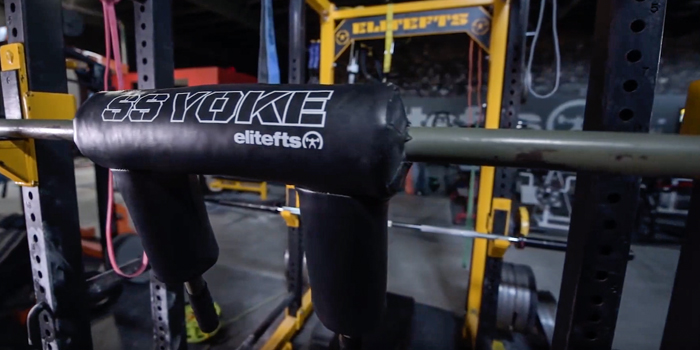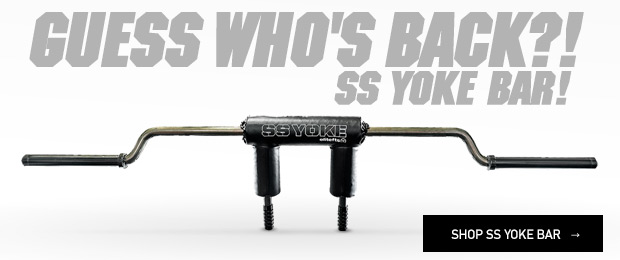
elitefts cofounder and CEO Dave Tate delves into the development of the elitefts SS Yoke Bar. He doesn’t like calling it a safety squat bar because this bar fills the yoke.
The difference between the two bars is in the design. The SS Yoke has a full-length pad, while safety squat pads are shorter. The problem with a shorter pad is that it puts a lot of compression on the spine. The shorter the pad, the less displacement there is across the upper back.
This doesn’t mean that you should avoid short pads entirely. It depends on the person.
Dave shows how the SS Yoke bar will eventually break in over a period of time and how it’s more supportive than the short pad.
Dave also shares his top 5 movements with the elitefts SS Yoke Bar. (Or as he calls them, “yoke boars.”)
1. Squats
There are several ways to do this, depending on what muscles you’re working on. The key here is using your hands to angle the bar as needed. A squat isn’t necessarily a squat. You could do a free squat, a squat with longer handles, a box squat... you’re looking at plenty of varieties of squats.
2. Upper Back Good Mornings
The upper back is a common weaker area for lifters and athletes. All it takes is rounding the upper back and arching it back up. Dave prefers to do these for time.
3. Good Mornings
Just the standard one here. The pad will be held higher, and you’ll have to pay a bit more attention with this bar, but it’ll focus on the hamstrings and glutes. This can be done in neutral, deadlift, and wide stances. You could also do an arched stance good morning. It’s not a bent-over good morning, though, so pay attention.
4. Back Raises
This can be any form of a back raise, even a glute-ham raise. It’s another way to load the back raise while you’re putting the load further away from the moving part, which makes it harder. The handles do come off the Yoke Bar, and elitefts is working on some new handles that’ll be coming out sometime in 2019.
5. Triceps Extensions
A basic extension here, where the pad acts as a level to keep tension on the triceps. There’s minimal shoulder rotation, which is good if you’re working those triceps. The pad acts as a guide to this extension.
Bonus 1: Single Leg Work
It’s a lot easier to do single leg work with the elitefts SS Yoke Bar than a straight bar. You can do lunges, the Bulgarian split squat...
Bonus 2: Dynamic Training with the SS Yoke Bar
Dynamic (speed) squat training with the SS Yoke Bar offers many strength benefits. First, it is a great way to build the explosive and static strength of the lower back, and many have found that this bar is a great way to increase your deadlift. Second, it takes much of the stress off the elbows and shoulders. This has a huge recovery effect on your bench training. This is of great value for lifters who are training for bench press-only meets, or those who are trying to recover from pectoral, shoulder, and elbow injuries. With the SS Yoke Bar, you’ll be allowed to train around your injuries and still get in a quality squat workout. Third, the SS Yoke Bar is great to use for GPP or lactic acid tolerance training. Listed below are some of the more popular squat cycles done with a safety squat bar:
Bonus 3: Lactic Acid Tolerance Training Cycle
Application: This is a great cycle for off-season training when you’d like to give your arms and shoulders a break. This is also a great way to peak your bench for a bench meet without having to stop squatting. This is good for beginners, intermediate, and advanced lifters.
Training Cycle (Three-week version):
- Week 1: 35% for 10 sets of 2 reps with 45-second rest periods
- Week 2: 37% for 15 sets of 2 reps with 30-second rest periods
- Week 3: 40% for 15-17 sets of 2 reps with under 30 seconds of rest
*The rest period for this week should be back-to-back sets. Two people should squat together and as soon as one lets go of the bar, the second guy should be grabbing the bar. Each lifter should try to wear the other out and see who dies first. Be aggressive and don’t lose.
Training Cycle (One-week version):
- Week 1: 37% for as many sets as possible of 2 reps with 30-second rest periods
*With this cycle, you should use a training partner that is close to the same strength as you, and try to run each other into the ground. We’ve seen battles go into and beyond 38 sets! Be aggressive and don’t lose.
Notes:
- Training percent is based on current one-rep max with the free squat with equipment.
- These percents are used as guidelines. The more advanced the lifters, the lighter the percent needed. If you’re a raw lifter or don’t use powerlifting gear, then a minimum of 10% should be added to the listed percents.
- All sets should be performed on a parallel box.
Bonus 4: Basic Three-Week “Straight Weight” Advanced Cycle
Application: This is a very good cycle for advanced lifters for off-season training, or as a deload cycle before a competition or test day.
Training Cycle:
- Week 1: 45% for 10 sets of 2 reps
- Week 2: 48% for 10 sets of 2 reps
- Week 3: 50 % for 10 sets of 2 reps
Notes:
- Training percent is based on current one-rep max with the free squat and equipment.
- These percents are used as guidelines. The more advanced the lifters, the lighter the percent needed. If you’re a raw lifter or don’t use powerlifting gear, then a minimum of 10% should be added to the listed percents.
- All sets should be performed on a parallel box.
- If you feel good after your sets, work up to a heavy double. This shouldn’t be done every week, but should be completed at least once through the cycle.
- You should rest no more than 45 to 60 seconds between sets.
Bonus 5: Basic Three Week “Chains” Intermediate Cycle
Application: This is a very good cycle for the intermediate lifter who has good squat skill and form. The chains will help develop a greater level of squat stability as well as increase the explosion from the bottom of the squat. This would be a very good off-season strength cycle for the intermediate lifter.
Training Cycle:
- Week 1: 50% for 8 sets of 2 reps
- Week 2: 53% for 8 sets of 2 reps
- Week 3: 55% for 8 sets of 2 reps
Suggested Chain:
- Squat Max: 200-400 pounds = 60 total pounds of chains
- Squat Max: 400-500 pounds = 80 total pounds of chains
- Squat Max: 500-600 pounds = 100 total pounds of chains
- Squat Max: 600-800 pounds = 120 total pounds of chains
- Squat Max: 800-950 pounds = 160 total pounds of chains
Bonus 6: Variations of Max Effort Squat Exercises with SS Yoke Bar
- Style: Free Squat, Box Squat, Suspended Squat, Off Pins
- Depth: High, Medium, Low
- Stance: Close, Medium, Wide
- Grip: On Handles Low, Handles High, On Bar, Longer Handles, Push Up or Pull Down
- Resistance: Weight, Band, Chain, Combination
- Position: On Back High, On Back Low, Front Squat, Zercher
Bonus 7: Variations of Good Morning Exercises with SS Yoke Bar
- Style: Free Squat, Seated Squat, Suspended Squat, Off Pins
- Depth: High, Medium, Low
- Stance: Close, Medium, Wide
- Grip: On Handles Low, Handles High, On Bar, Longer Handles, Push Up or Pull Down
- Resistance: Weight, Band, Chain, Combination
- Position: On Back High, On Back Low, Zercher
Bonus 8: Uses for Non-Conjugate Training Programs
- Short Blocks to take stress off shoulders
- Close stance to bring up conventional deadlift
- Supplemental movement to bring up upper back and/or quads
- Way to vary workload while keeping intensity high
There even more exercises you can do with this bar than the ones you see here. It can get a bit ridiculous with how many things you can do with it. You could make a list of 99 things you can do with that, but Dave thinks that’s an upsell, and you don’t need an upsell with the high-quality elitefts SS Yoke Bar.
It’s just that good.









